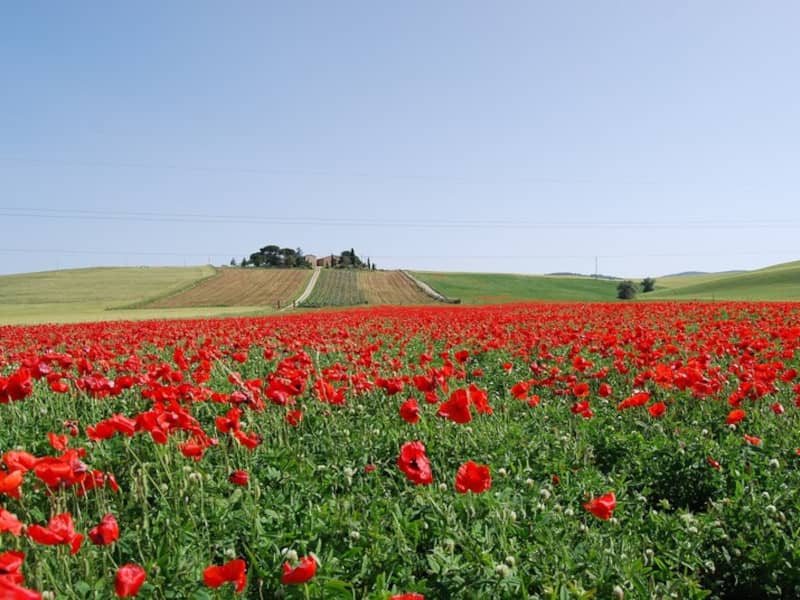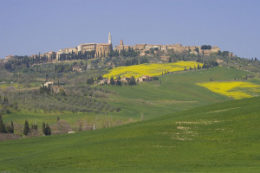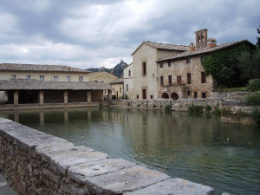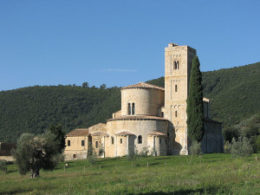
Renaissance landscapes in the Val dOrcia
The Val d’Orcia is located in the Tuscan hills. Its magnificent landscape has made it rightly in the UNESCO World Heritage List already in 2004.
Here you can find beautiful landscapes and enchanted places of art.
According to UNESCO this valley is an exceptional example of how the natural landscape was redesigned during the Renaissance and reflects the ideals of “good government” (14th and 15th century) typical of the Italian city-state, whose splendid places were celebrated by the painters of the Sienese School, which flourished between the 13th and 15th centuries.
The richness and variety of the landscape are not the only elements that characterize this uncontaminated territory: the wine and food production is in fact one of its strong points: the cacio pecorino cheese of Pienza, the honey of Val d’Orcia, the extra-virgin olive oil of Castiglione d’Orcia, the cold cuts of Cinta Senese, mushrooms and truffles, and one of the most famous wines in the world: Brunello di Montalcino.
The Val d’Orcia has linked its destiny to the Via Cassia, the great Roman road that connected Rome with northern Italy and that crosses the entire valley and that, for most of its route, follows the historic Via Francigena.
The continuous transit of men and goods along this fundamental connecting road decreed the importance of some towns in the area until it aroused the interest of the Republic of Siena in the 15th century.
After the middle of the sixteenth century, the Val d’Orcia entered into the Florentine orbit together with the Sienese dominions, preserving only the value of an agricultural area.
Castiglione d’Orcia, Montalcino, Pienza, Radicofani and San Quirico d’Orcia are the five splendid municipalities that have chosen to give life to the Val d’Orcia Park to protect the environment and the territory and to promote the brand.
What to see?

Pienza: the capital of the Val d’Orcia wanted by Pope Pius II, with its splendid square, Renaissance palaces and panoramic views.
San Quirico d’Orcia: probably dates back to Etruscan times. To visit the remains of the tower of Casseri and the Horti Leonini, a splendid sixteenth century garden from which you can access the main square of the village. But also the collegiate church, the parish church and the splendid fortresses.
Between Pienza and San Quirico d’Orcia along the Provincial Road 146 of Chianciano you can visit the Chapel of Vitaleta, a magical place where you can breathe peace and serenity but to reach it you will have to walk a bit.

Bagno Vignoni is one of the most charming and romantic villages in the whole Val d’Orcia. Famous since Roman times for its thermal waters: popes, kings and knights have stopped here to enjoy its waters. Its central square is entirely occupied by a large thermal bath, ideal for a romantic dinner.

Montalcino: when you talk about Montalcino you immediately think of Brunello, which has made this village famous all over the world. But Montalcino is also a city rich in art and history. A beautiful medieval village from which you can enjoy a breathtaking view. To visit the fortress, Piazza del Popolo, churches and museums, but above all do not miss the Abbey of Sant’Antimo a few kilometers from the village.
The Quercia delle Checche is the first green monument in Italy. A giant in Val d’Orcia, a patriarch of nature. It is 22 metres high and its foliage extends for 19 metres horizontally. The majesty of the oak leaves you speechless, it is beautiful to stand under its branches and admire its majesty.
Castiglione d’Orcia and its fortress: a small medieval village all gathered around the splendid 14th century fortress. In front of Castiglione d’Orcia stands Rocca d’Orcia where you can visit the ancient fortress of Tentennano to admire the view: a unique point of view.
Monticchiello, a typical medieval village, perched on a hill. Mighty walls, a single gateway overlooking the Val d’Orcia and picturesque narrow streets. A unique beauty just outside the main tourist itineraries. In Monticchiello time has stopped.















